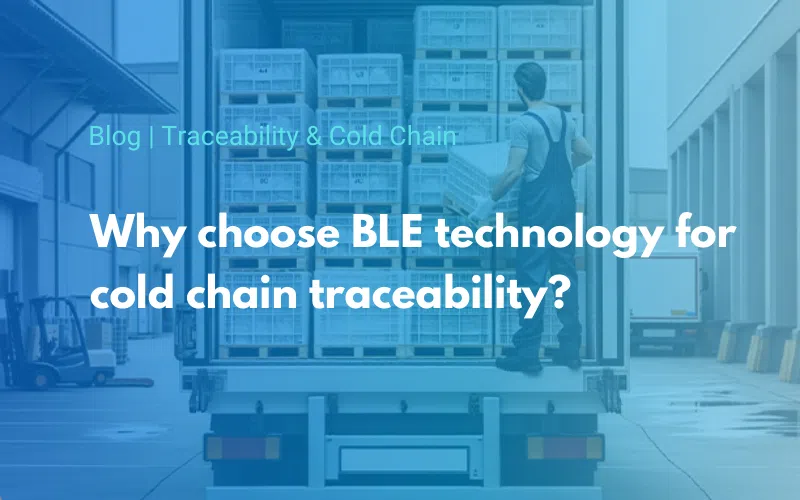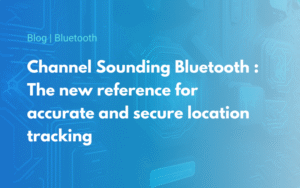
Traceability of temperature and humidity conditions has become a key issue in many sectors subject to strict sanitary standards. Whether for food, pharmaceutical or biological products, maintaining a continuous cold chain is essential to guarantee the quality and conformity of goods throughout the logistics cycle. To meet these growing needs, connected sensor technologies have become widely available, among which Bluetooth Low Energy (BLE) has emerged as a particularly relevant solution.
The benefits of BLE for cold chain traceability
BLE is distinguished above all by its low energy consumption, enabling sensors to operate for several years without battery replacement. This reduces maintenance requirements and facilitates large-scale deployment on containers, pallets or vehicles.
Thanks to its wireless communication capabilities, BLE automatically transmits environmental data (temperature, humidity, door opening, etc.) to compatible gateways or smartphones. Data can be transmitted in real time or stored locally.
BLE is based on a widely adopted open standard, ensuring interoperability with a wide variety of mobile systems and devices. This simplifies integration into existing supply chains, without the need for proprietary infrastructure.
Last but not least, its adaptable range (from a few meters to several tens of meters, depending on conditions) enables efficient tracking in warehouses, cold stores or during transport.
BLE applications in cold chain traceability
Industry 4.0
In industrial environments, BLE is used to monitor temperatures in cold rooms, on packaging lines or in transport bins. It can also be used to detect breaks in the cold chain during transfers between workshops, thanks to automatic data collection via fixed or mobile gateways.
Smart Building
In intelligent buildings (central kitchens, supermarket warehouses, laboratories), BLE enables centralized management of temperature and humidity parameters. It facilitates the monitoring of cold rooms, the detection of alarms when thresholds are exceeded, and contributes to the building’s overall energy management.
Healthcare
In the medical and pharmaceutical sectors, BLE ensures the traceability of vaccines, blood bags or heat-sensitive drugs. It is used during transport between the factory, hospital and pharmacy, and in hospital refrigerators for continuous monitoring of storage conditions.
Transport and telematics
BLE is widely deployed in refrigerated vehicles to monitor temperature and humidity, detect the opening of doors, or check the activation of the refrigeration system. It is particularly useful in last-mile deliveries, especially for tracking isothermal boxes, where the risk of breakage is high.
Want to know more? Read our article on how to guarantee the safety of the cold chain during transport.
Construction
On construction or technical sites, certain materials (adhesives, resins, chemicals) need to be stored at controlled temperatures. The BLE enables these conditions to be monitored in mobile containers or refrigerators, guaranteeing that the materials are fit for purpose.
Smart Agriculture
In connected agriculture, BLE helps to monitor cold storage facilities (fresh produce, milk, seeds), prevent losses and ensure compliance with sanitary standards.
What are the alternatives to BLE in industrial asset tracking?
BLE vs Wirepas
Wirepas uses a self-organizing mesh network, suitable for sensor-dense environments. However, this technology requires a heavier software infrastructure and more complex integration. BLE, on the other hand, can be easily connected to standard smartphones or gateways, facilitating its deployment in logistics environments.
BLE vs Quuppa
Quuppa is based on ultra-precise localization (Angle of Arrival). Although it offers centimetric precision, it requires a dense and costly antenna infrastructure. BLE, though less precise, is sufficient for the majority of cold chain applications, and more economical to implement.
BLE vs Wi-Fi
Wi-Fi is common on industrial sites, but its energy consumption is much higher, making it unsuitable for battery-powered autonomous sensors. BLE operates on a more stable frequency for short communications, enabling more granular tracking without overloading the main network.
Why BLE is the ideal technology for cold chain traceability
BLE combines low power consumption, interoperability, sufficient range, security and mobile compatibility. It stands out for its ease of deployment and agility, offering a reliable, cost-effective and scalable solution for environmental traceability. Unlike more complex or costly technologies, this technology offers excellent value for money, without compromising on data quality. BLE is emerging as a key technology for cold chain traceability.

Discover our range of Bluetooth Low Energy beacons
What are the recent and future developments in cold chain traceability?
The latest advances in Bluetooth Low Energy, with versions Bluetooth 5.2 and soon 6.0, further improve location accuracy and transmission capacity, while maintaining low energy consumption. Features such as Bluetooth Channel Sounding pave the way for more precise localization, useful for quickly identifying a break in the cold chain.
These innovations make BLE sensors even more powerful: autonomous, intelligent, and integrated into increasingly complex IoT systems. This makes the cold chain more reliable, more transparent and more responsive to logistical or environmental hazards.

